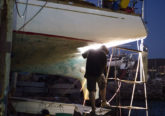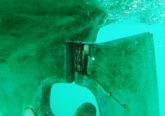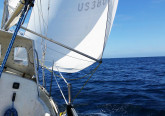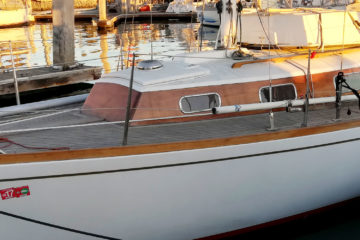(If you’re just interested in getting more information on anchoring in Cat Harbor and Emerald Bay, then feel free to skip this personal dribble and head down to their sections, located below)
This post about sailing out and anchoring on Catalina Island wasn’t supposed to happen, as it should have actually been written about Santa Cruz Island. But I suppose one Channel Island is as good as another, right?
From the get-go this trip was rocky: leaving late (4 pm or so), a dirty carb (required two cleanings in twenty minutes) and how could I forget, seeing my beloved MacBook Pro fly off the galley table (one which I was sure had tall enough sides to contain it) and onto the cabin sole during a roll.
But once the initial unwanted excitement settled I quickly began looking forward to a more predictable rest of the trip…or so I thought.
There were a few reasons for this voyage:
- A longer-than-previously-experienced duration aboard non-stop (predicted to double the time of the trips up from San Diego which were taken after purchasing my first and second Albin Vegas)
- A chance to practice anchoring with my beautiful new 25 lbs Mantus anchor (plus the Mantus dinghy anchor!)
- Take my friend Salomé on a trip that is a bit different from the usual Los Angeles tourist path. She was visiting from France and looking for adventure.
- Find out if my solar/wind generation setup would be sufficient to keep up with normal operations.
- Verify the workability of my navigation setup (consisting primarily of free software and charts from OpenCPN, running on Android devices and my Mac).
- Learn to use my Fleming Wind Vane autopilot. Verify my engine woes were cured (already failed that one). Verify my propane setup was adequate. Etc.

With so many systems to check, I wasn’t going to let a few early hiccups get in the way of my priorities.
So there we were Thursday evening, bobbing along off the coast of San Pedro, sticking to my course generated by FastSeas.com. Relaxing, enjoying the novelty of the situation, happy to be exactly where we were.
Fast forward 24 hours.
Salomé was over the leeward side of the boat, vomiting uncontrollably into the water. She was anemic and probably getting dehydrated, at this point having been getting sick regularly for about 5 hours. No sign of her seasickness abating.
I was feeling a bit nauseous as well. If not by the seasickness then by our slow progress. We were moving significantly slower than predicted. I knew beating into the wind sucked, but our forward progress was worse than my already conservative prediction. We couldn’t point as well as anticipated…I was dreaming of a jib that held it’s shape better. And I was not oblivious to the likely possibility that my upwind sail trimming skills needed work.
Another nagging reality is that we weren’t generating power quick enough to keep up with our consuming it. Certainly nothing to worry about it, annoying nonetheless – looks like I’ll need to add a coupe solar panels. Fine, great, whatever. Glad to have recognized it during a shakedown.
But at this point we did need to make a decision. Should we keep beating upwind to Santa Cruz Island, or compromise with a trip to Catalina? Continuing to SCI would mean arriving late, and because Salomé’s flight was within a day of our return, maybe leaving early to insure a time buffer. And of her seasickness, should we assume it will continue or subside? And in considering all of this – is the point of this trip for fun or for valiance?
After a few hours of stubborn resolve to continue as planned, we came to the decision to bear off and change course for Catalina. If for nothing else, then for the health and comfort of my French compatriot. In all honesty, at this point I wasn’t opposed to the idea.
So we did, and all at once (as anyone who sails knows) the mood changed. With the wind behind us things calmed, the boat steadied and we were making progress directly towards our destination, Cat Harbor (known officially as Catalina Harbor).
Anchoring in Cat Harbor

By the morning we were sailing south along the westside of Catalina, and by noon we had arrived at Cat Harbor. In preparation for arriving at an anchorage of which I was unfamiliar, I did some reading in my copy of Charlie’s Charts of the U.S. Pacific Coast. Once in the harbor however, I was a bit confused where we were allowed to anchor, and where was off limits. To be fair, I have the second edition. Maybe the latest (the sixth) is more illuminating.
In the end we anchored in an area that, according to my interpretation of Charlie’s Chart, had a foul bottom. We didn’t experience anything foul about it, but there were some areas which I could see might be deserving of the designation.
In our anchorage, everyone had both bow and stern deployed. I was extremely please with my new 25 lbs Mantus anchor. At a scope of about 3:1 (thought I was at 5:1, I found out later I didn’t have as much chain as I was originally told) it set and didn’t budge. I really love the little thing, not in the least because it’s so reasonably priced.
In the stern I deployed my Fortress FX-11, and was also pleased with it’s ability to sit and stay once set.
We remained in Cat Harbor for 3 nights, before making the move to Emerald Cove. While wandering the area, we realized we had come during Buccaneer Days, which explains all the drunk pirates we saw staggering around.
Anchoring in Emerald Cove

The heading of this section may as well be mooring in Emerald Cove, because as it turns out, that’s just what we did. Quick info for reference, a 40-45 foot mooring was, IIRC, $43 per night. If you pickup an empty one, a Harbor Patrol boat should eventually come by to give you a reservation number, which is used to pay via phone within a few days of your stay.
The trip from Cat Harbor to Emerald Cove was rather unremarkable up to the final two minutes of it. Before that point the engine had not given us any issues since the extra cleaning prior to leaving the marina. But just as we entered Emerald Cove to scope out an anchorage (again, it wasn’t clear from Charlie’s Charts where exactly we were allowed to anchor), the engine bobbled, and as soon as I rolled off the throttle it died all together and wouldn’t restart.
We were in the middle of the (almost completely empty) mooring field and in my haste I deployed the anchor, when I should have just picked up a mooring temporarily. Once we were secured I got to work on the engine again, but a quick cleaning of the idle jet did not cure the issue this time. So I decided to further troubleshoot by pulling the carb off.
I’d never done it on this engine before (a 2009 Tohatsu 9.8 4-stroke) but it would turn out to be very easy, with just two bolts, a screw and a single wire connection. Once off I disassembled the carb, cleaned all the jets/passages/bowl and reinstalled it. It ran temporarily but what I came to realize is when I pulled the bowl off, it broke the seal and because of the age, the o-ring had become completely flat. So not only did it leak fuel out the sides but also the fuel pump would force it past the float needle, flooding my engine.
Great. Of course I don’t have an extra float bowl gasket (who does?) so my only possible solution was using silicone given to me by a very kind Harbor Patrol worker. Cleaned, applied, installed. I wasn’t going to attempt to use it though, until the stated dry time had passed. I wanted to give it every chance possible to succeed. So in the end we brought in the anchor grabbed a mooring and called it a day (I had to dive on the Mantus anchor to get it back, as it’d caught on a mooring chain. Guess that’s why you don’t anchor in a mooring field, eh?).

The next day we were enjoying ourselves too much to stress about moving. I had no confidence in the borrowed silicone. The little bit which I saw that was dry was awful. It seemed to have no resolve to hold, even without pressurized gasoline trying to force it’s way by. So I felt the only possible solution was to stay on the mooring that night, sail out of Emerald the next day and only attempt to use the engine once we’re nearly at the marina, since I figured the silicone would fail in short time.
Well the next day went exactly as planned. We lifted sails and dropped the mooring ball around 10 am, and were well on our way back. It was an easy sail of about 6 hours, with the wind mostly to our backs. An issue with one of my stanchion rails partway through caused me to place my dinghy engine (a Yamaha 2.5) on the cockpit sole. This later turned out to be an issue.
As we neared the marina, the moment of truth arrived. I would need to start the engine up and hope it gets us home. All was going well until about 75 yards after entering the marina when the engine died and wouldn’t restart. Super…dropped the anchor, opened the engine and tried the idle jet trick, but that didn’t solve the problem. With that, I could deduce the silicone had failed and we were flooding the engine.
So with engine #1 out commission, I decided to try engine #2. I lashed the Avon Redcrest dinghy to the starboard side and placed the always reliable Yamaha 2.5 on the back. Guess what? That engine also failed to run. Following an initial carb cleaning when I first purchased it, the engine had never failed to run (we had even used it at Cat Harbor). I believe the reason for the sudden problem, came from when I placed it on the cockpit sole. To this point it’d always been stored vertical, either on rail mount or the dinghy. When I set it down during our return, sediment which had accumulated over time fell from the bottom of the bowl into the orifices/jets.
Convinced this trip would never end, I pulled apart the carb while still mounted to the dinghy and did my best to clean it out. My pressured sprayer (a CO2 duster) had run out, so I was forced to make do with blowing. After reassembly, I was able to get the engine running (poorly) but decently enough to get partial throttle from it.
I had Salomé jump in and keep the engine alive, while I steered us home to our slip. All in all it was an unfortunate, though technically harrowing end to the journey. I was able to do all the systems testing I wanted, and found a number of issues in some primary systems.
At this point it was about 8 pm and we were both starving. Since it was Tuesday night, we donned the sandals and headed for Taco Tuesday at Tequila Jack’s.








No Comment